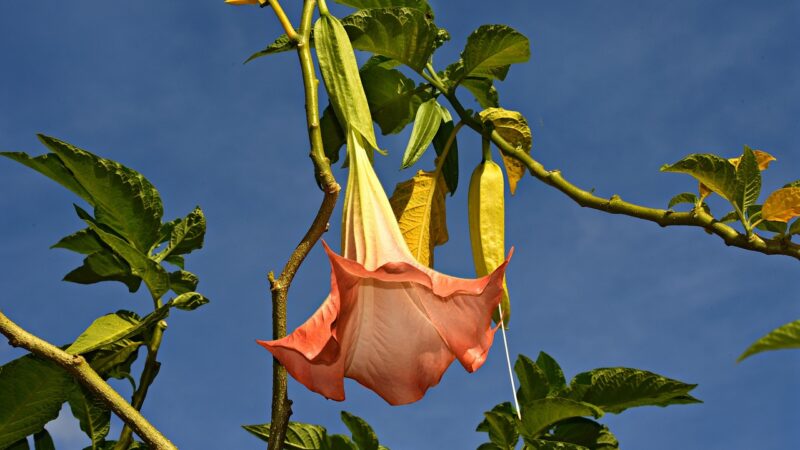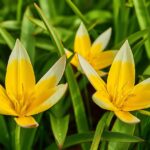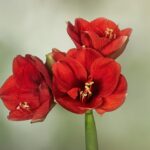The care of angel’s trumpet

Brugmansia, commonly known as angel’s trumpet, represents a genus of stunning, arborescent flowering plants that command attention in any garden setting. These subtropical shrubs or small trees are renowned for their large, pendulous, trumpet-shaped flowers that release an intoxicating fragrance, particularly in the evening hours. To successfully cultivate these magnificent specimens, a deep understanding of their specific needs is paramount, as their vigorous growth and prolific flowering are directly tied to the quality of care they receive. This involves a holistic approach that considers everything from their environmental preferences to their substantial nutritional and water requirements throughout the active growing season. A well-tended Brugmansia can become a true centerpiece, rewarding the diligent gardener with successive waves of breathtaking blooms from spring until the first frosts.
Caring for an angel’s trumpet begins with acknowledging its origins in the subtropical regions of South America, which dictates its fundamental needs for warmth, humidity, and protection from harsh conditions. These plants are not frost-tolerant and require a climate where temperatures consistently remain above freezing. In temperate zones, this necessitates growing them in large containers that can be moved to a protected location during winter. The sheer size and rapid growth rate of Brugmansia mean that they are heavy feeders and drinkers, a factor that cannot be overlooked. Providing them with consistent moisture and a steady supply of nutrients is the key to unlocking their full potential for both lush foliage and a spectacular floral display.
The structural aspect of care is also critically important for the health and aesthetic appeal of the plant. Regular pruning is not merely for size control but also for encouraging the development of a strong framework capable of supporting the weight of its massive blooms. It also plays a vital role in stimulating the growth of new flowering wood, as Brugmansia typically flowers on new growth. Understanding the plant’s growth habit, specifically the point at which the main stem forks into a ‘Y’, is crucial for effective pruning that enhances flowering rather than inhibiting it. This ongoing maintenance ensures the plant remains vigorous and well-shaped year after year.
Finally, a crucial aspect of caring for Brugmansia is a constant awareness of its toxicity. All parts of the angel’s trumpet plant are poisonous if ingested, containing potent alkaloids. This requires careful handling, such as wearing gloves when pruning, and strategic placement in the garden, especially in areas frequented by children and pets. Responsible ownership means balancing the enjoyment of its ornamental beauty with a firm commitment to safety. Educating oneself and others about these properties is a non-negotiable part of cultivating these extraordinary plants responsibly and without incident.
Understanding the plant’s basic needs
At its core, Brugmansia is a heat-loving plant that thrives in environments that mimic its native habitat. It performs best in conditions of high humidity and consistent warmth, making it particularly well-suited for long, warm growing seasons. The ideal temperature range during its active growth period is between 18 and 28 degrees Celsius. While established plants can tolerate brief spells of slightly cooler or warmer weather, prolonged exposure to temperatures outside this range can induce stress, leading to a decline in vigor, leaf drop, and a reduction in flowering. It is this sensitivity to cold that defines its cultivation in many parts of the world as a tender perennial.
More articles on this topic
The plant’s demand for resources is directly proportional to its rapid growth. During the peak of the growing season, a mature Brugmansia can grow several centimeters in a single day, a feat that requires a substantial and continuous supply of both water and nutrients. This voracious appetite means that the soil must be kept consistently moist, but not waterlogged, as root rot can be a significant issue in poorly drained soils. The gardener must be prepared to provide copious amounts of water, especially during hot, dry weather, often on a daily basis for container-grown specimens. This commitment is fundamental to maintaining the plant’s health and ensuring it has the energy reserves for its spectacular flowering.
Beyond warmth and water, the structural integrity of the plant is supported by its environment. While Brugmansia enjoys bright light, it benefits greatly from protection against the harsh, direct sun of midday, particularly in hotter climates. A location that receives ample morning sun and filtered or dappled afternoon shade is often ideal, as this prevents the large, soft leaves from wilting and scorching. Furthermore, its large leaves and pendulous flowers make it susceptible to damage from strong winds, which can shred the foliage and break the woody, yet somewhat brittle, branches. Selecting a sheltered position is therefore a key strategic decision for its long-term well-being.
Finally, the soil environment is a critical component of its basic needs. Brugmansia requires a rich, well-draining, and slightly acidic to neutral potting mix or garden soil. The medium must be capable of retaining adequate moisture to satisfy its thirsty roots while also allowing excess water to drain away freely to prevent anaerobic conditions. Incorporating generous amounts of organic matter, such as well-rotted compost or aged manure, is highly beneficial. This not only provides a slow release of essential nutrients but also improves the soil’s structure and water-holding capacity, creating the perfect foundation for a healthy root system.
The importance of location and light
Choosing the correct location for an angel’s trumpet is one of the most impactful decisions a gardener can make for its success. The ideal placement strikes a delicate balance between providing sufficient light for photosynthesis and prolific blooming, while also offering protection from the most intense solar radiation of the day. In most temperate climates, a position that receives at least six to eight hours of direct morning sunlight is considered optimal. This early-day sun exposure fuels the plant’s energy production without the associated stress of intense afternoon heat, allowing the foliage to remain turgid and healthy.
More articles on this topic
In regions with particularly hot and intense summers, providing afternoon shade is not just beneficial, it is often essential. The large, soft leaves of Brugmansia have a high rate of transpiration, and when exposed to scorching afternoon sun, they can lose water faster than the roots can absorb it, leading to significant wilting and leaf scorch. This stress can weaken the plant over time, making it more susceptible to pests and diseases, and can also lead to a reduction in the size and quantity of its flowers. A spot on the east-facing side of a house or beneath the canopy of a tall, deciduous tree can provide the perfect combination of morning sun and afternoon respite.
The quality of light also influences the plant’s growth habit. In conditions of insufficient light, a Brugmansia will tend to become ‘leggy’, characterized by elongated stems with sparse foliage as it stretches in search of a better light source. While the plant may survive in lower light, flowering will be significantly reduced or may fail to occur altogether, as the plant lacks the necessary energy to produce its large, complex blooms. Therefore, monitoring the plant’s growth pattern can provide valuable clues about whether its current location is meeting its photosynthetic needs. A compact, densely foliated plant is a good indicator of adequate light exposure.
For container-grown specimens, the choice of location offers greater flexibility. These plants can be moved throughout the season to optimize their light exposure, for instance, by placing them in full sun during the cooler months of spring and autumn and shifting them to a more protected, partially shaded spot during the peak of summer. This adaptive management allows the gardener to respond to changing weather patterns and the sun’s seasonal path across the sky. It also simplifies the process of moving the plant to its overwintering location when temperatures begin to drop, making container cultivation a popular and practical choice for many gardeners.
Soil requirements and potting mediums
The foundation of a healthy Brugmansia is, quite literally, the soil it grows in. These plants require a medium that is both rich in organic matter and exceptionally well-draining. A heavy, compacted soil that retains excessive water will quickly lead to root rot, a condition to which angel’s trumpets are particularly susceptible. The ideal soil structure should be loose and friable, allowing for strong root development and adequate aeration. For garden planting, this often means amending the native soil heavily with materials like compost, well-rotted manure, and coarse sand or perlite to improve both fertility and drainage.
When cultivating Brugmansia in containers, the choice of potting medium is even more critical, as the plant’s entire root system is confined to a limited volume of soil. A high-quality, commercial potting mix designed for large containers or shrubs is a good starting point. However, to truly meet the demands of this heavy feeder, it is advisable to enhance this base mix further. Incorporating additional organic matter such as compost or worm castings will provide a slow release of nutrients and improve moisture retention. Adding perlite, pumice, or fine pine bark can significantly enhance drainage and prevent the mix from becoming compacted over time.
The pH of the soil is another important factor to consider for optimal nutrient uptake. Brugmansia prefers a soil pH that is slightly acidic to neutral, typically in the range of 6.0 to 7.0. Within this range, essential nutrients like nitrogen, phosphorus, and potassium, as well as various micronutrients, are most readily available to the plant’s roots. If the soil is too alkaline, it can lead to nutrient lockout, where certain nutrients are present in the soil but cannot be absorbed by the plant. This often manifests as yellowing leaves (chlorosis) and stunted growth. A simple soil test can determine the existing pH, which can then be adjusted if necessary.
Given the plant’s vigorous growth, container-grown specimens will eventually exhaust the nutrients in their potting medium and can become root-bound. It is therefore necessary to repot them periodically, typically every one to two years, or when signs of stress become apparent. This process involves moving the plant to a slightly larger container and replacing the old, depleted soil with a fresh, nutrient-rich mix. Repotting not only replenishes the growing medium but also provides an opportunity to inspect the root system, trim any circling or damaged roots, and ensure the plant has adequate space for continued growth.
Pruning strategies for health and blooms
Pruning is a fundamental aspect of Brugmansia care, essential for maintaining the plant’s size, shape, health, and, most importantly, its ability to flower prolifically. The primary goal of pruning is to encourage the growth of new wood, as angel’s trumpets produce their spectacular flowers on the current season’s growth. Understanding the plant’s unique branching structure, specifically the formation of a ‘Y’ in its stems, is key to successful pruning. Flowers will almost exclusively form on branches that have developed above this initial ‘Y’. Therefore, any pruning should aim to preserve this primary structure while encouraging further branching above it.
The timing of pruning is crucial. The main, structural pruning is best performed in late autumn before the plant is brought indoors for winter, or in early spring just as new growth is about to emerge. Pruning in the autumn helps to reduce the plant’s size, making it more manageable for overwintering. A spring pruning allows for the removal of any winter-damaged or dead wood and helps to shape the plant for the upcoming growing season. Throughout the summer, light maintenance pruning can be done to remove any yellowing leaves, spent flower stalks, or wayward branches to maintain a tidy appearance and direct the plant’s energy towards new flower production.
The technique used for pruning will depend on the desired outcome. For general maintenance and to encourage more flowers, one can trim back the side branches above the main ‘Y’ formation, cutting back to a node that faces outward. This will stimulate the development of multiple new shoots from that point, each capable of producing flowers. It is important to use clean, sharp pruning tools to make precise cuts that heal quickly, minimizing the risk of disease entry. For overgrown plants, a more significant ‘rejuvenation’ pruning can be undertaken, cutting the main branches back by as much as two-thirds, which can reinvigorate an older specimen.
It is also important to consider what not to prune. The main trunk or stem below the first ‘Y’ should generally not be cut back unless one wishes to retrain the plant into a different form, as this will delay flowering significantly. New growth that emerges from the base of the plant, known as suckers, should typically be removed as they divert energy from the primary, flowering structure. By employing a thoughtful and strategic approach to pruning, the gardener can effectively manage the plant’s growth, enhance its structural integrity, and maximize its stunning floral display season after season.
Managing toxicity and ensuring safety
A fundamental responsibility in the cultivation of Brugmansia is the diligent management of its inherent toxicity. Every part of the angel’s trumpet plant, from its roots to its leaves, flowers, and seeds, contains a potent combination of tropane alkaloids, including scopolamine and atropine. These substances are highly toxic if ingested and can cause a range of severe symptoms, including hallucinations, paralysis, and in extreme cases, can be fatal. This is not a plant to be taken lightly, and its cultivation requires a mature and responsible approach to ensure the safety of everyone who may come into contact with it.
Due to this toxicity, the placement of the plant in the garden or on a patio is a primary safety consideration. It is imperative to position Brugmansia in areas that are not accessible to curious children or pets who might be tempted to chew on a leaf or flower. Even the nectar of the flowers contains these alkaloids. Locating the plant away from play areas, walkways, and pet enclosures is a crucial first step. For those with a significant concern, growing the plant in a contained, private section of the garden might be the most prudent course of action, ensuring its beauty can be admired from a safe distance.
Proper handling practices are also non-negotiable when working with angel’s trumpets. It is strongly recommended to wear waterproof gloves and long sleeves whenever pruning, repotting, or otherwise handling the plant. This prevents the sap from coming into direct contact with the skin, as some individuals may experience a topical reaction. After working with the plant, it is essential to wash hands and tools thoroughly with soap and water. These simple precautions significantly reduce the risk of accidental exposure to the plant’s toxic compounds.
Finally, education is a key component of safe cultivation. Anyone who grows Brugmansia should be fully aware of its properties and should take the time to inform family members, visitors, and neighbors of the potential danger. Clearly communicating that the plant is poisonous and should not be touched or ingested is part of responsible ownership. This knowledge-sharing ensures that the plant is respected for its powerful nature, allowing its breathtaking beauty to be enjoyed without compromising safety. The allure of the angel’s trumpet is undeniable, but it must always be tempered with caution and respect.
Advanced techniques for the enthusiast
For the dedicated Brugmansia enthusiast, moving beyond basic care into more advanced techniques can lead to even more spectacular and rewarding results. One such technique is the practice of training the plant into a specific form, such as a ‘standard’ or tree-like shape. This is achieved by selecting a single, strong, straight stem as the main trunk and systematically removing all side shoots and lower leaves as it grows. Once the trunk reaches the desired height, the top is pruned to encourage the development of a bushy, branching canopy, creating a highly elegant and formal presentation that showcases the pendulous flowers beautifully.
Another advanced area of focus is the manipulation of flowering cycles. While Brugmansia naturally flowers in flushes throughout the growing season, experienced growers can influence the timing and intensity of these displays. This often involves a carefully controlled feeding regimen, switching to a high-phosphorus fertilizer (often called a ‘bloom booster’) as the plant shows signs of setting buds. Some growers also employ strategic light pruning, tipping back the ends of green, non-flowering shoots to encourage the development of more flowering branches. This level of intervention requires close observation and an intimate understanding of the plant’s growth patterns.
Hybridizing is perhaps the ultimate advanced technique for the true Brugmansia aficionado. This involves the deliberate cross-pollination of two different parent plants in an effort to create a new, unique cultivar with desirable traits, such as a new flower color, a more complex petal arrangement, or enhanced fragrance. The process is meticulous, requiring the careful transfer of pollen from the anther of one flower to the stigma of another, followed by the protection of the pollinated flower to prevent contamination. If successful, a seed pod will form, and the resulting seeds can be grown out to see what new creations have been born, a process that requires immense patience and a bit of luck.
Finally, mastering propagation through more challenging methods like grafting represents a high level of skill. Grafting involves joining the tissue of two different plants so they continue their growth together. In the context of Brugmansia, a grower might graft a less vigorous but beautifully flowered cultivar onto the robust rootstock of a hardier variety. This can improve the overall vigor and disease resistance of a prized specimen. This technique requires precision, sterile tools, and a controlled environment for the graft to heal successfully, but it opens up a world of possibilities for preserving and enhancing specific genetic lines.



















